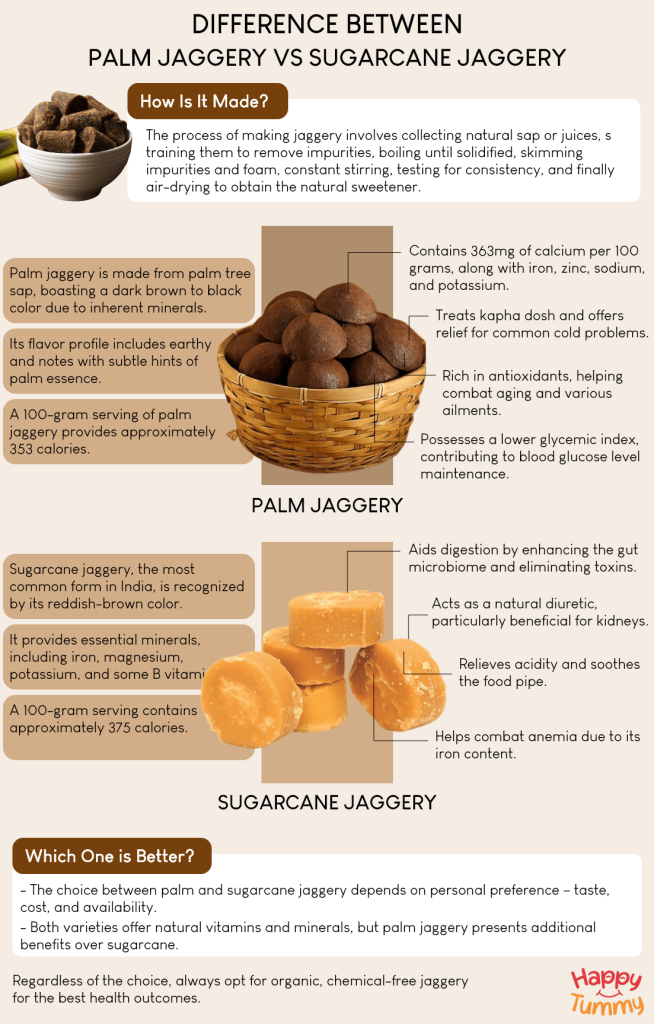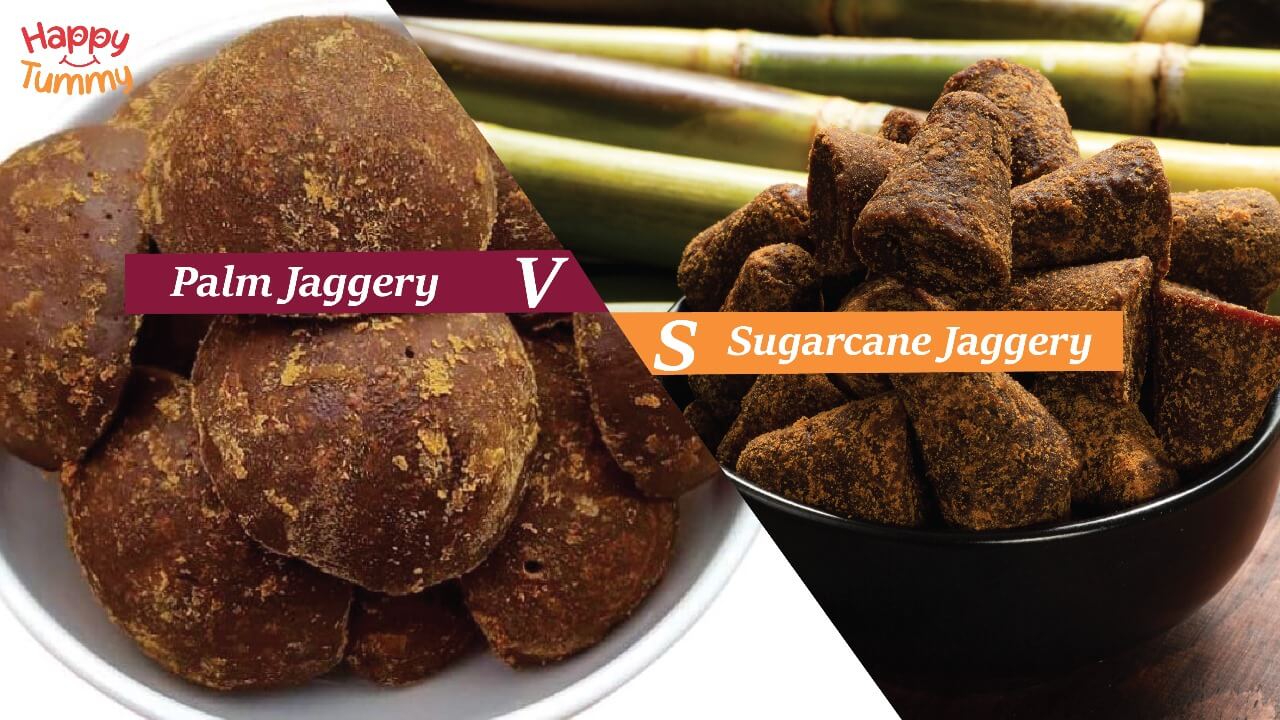Table of Contents
India and Indian cuisine go pan in pan. It is known for its spices, for its curries, and for its many sweet delights. Sheer bliss! And out of the many sweet sustenances, there is one that you’ll rarely find out of India – Jaggery. Sugar is surely considered unhealthy by many health enthusiasts. But jaggery? It takes pride in being healthy.
Much before sugar was even a word, jaggery (also known as ‘gud’) was used to sweeten tea and milk and other dishes. It is healthy. It is delicious. And best of all, it is unprocessed.
But most often, there remains a dense fog around two common types of jaggery – palm and sugarcane. But what is the actual difference between these two? And what wins the battle of palm jaggery vs sugarcane jaggery?
Let’s find out by starting on a sweeter note.
Jaggery – How Is It Made?
Jaggery, sesame, and peanuts – this triad blesses the onset of many festivals across India. Especially in Makar Sankranti, ‘gud and til’ laddoos are famous. But the question is, how is jaggery made? And how do their preparation processes impact their quality, benefits, and nutritional content?
The jaggery-making process is simple – heat up natural sap or juices till they are solidified.
Or might be, it is not that simple.
Here is the complete jaggery-making process –
- Collect sap or juices
- Strain the juice to filter the impurities
- Boil, boil, and boil
- Skim the impurities and foam rising on the surface during boiling
- Keep stirring
- Test for consistency
- Pour into moulds or flat surface
- Leave to get air-dried and solidified
And there you have it – a natural sweetener that is delicious and healthy.
Jaggery is so healthy that it was even used as medicine in the Ayurvedic times. [1]
But, what is this palm jaggery vs sugarcane jaggery debate all about?
To better understand which jaggery is best, we’ll be picking them one by one and tasting their origin, nutritional values, and the many benefits out there.
So, let’s start with the famous one – sugarcane
Sugarcane Jaggery – Nutrition and Benefits
Sugarcane jaggery is the most common form of jaggery in India. Go to any shop and ask for jaggery – chances are that you’ll find the sugarcane one.
One thing you might get bewildered with is the colours of different jaggeries. True sugarcane jaggery always has a rich reddish brown colour. If you see it in orangish or yellowish shades, it is the processed one.
Once you put the true jaggery in your mouth, you’ll sense deep, caramel-like notes with hints of toffee, molasses, and a subtle earthiness, melting into your mouth.
Nutrition-wise, sugarcane jaggery is a source of essential minerals such as iron, magnesium, and potassium, along with small amounts of B vitamins. Best of all, it also contains antioxidants.
A 100-gram of sugarcane jaggery provides around 375 calories. [2]
The many benefits of sugarcane jaggery
- Helps in digestion – Gud promotes digestion by flushing out toxins and enhancing the gut microbiome.
- Natural diuretic – According to Ayurveda, ‘gud’ is an important medicine. It treats kapha dosh and acts as a natural diuretic. This benefits kidneys too.
- Relieves acidity – Sucking on a small piece of jaggery can help you calm down your furious food pipe.
- Helps in anaemia – Sugarcane contains a good amount of iron within its toothsome composition. Eating it regularly can help you have your daily portion of iron.
Now, let’s climb up some palm trees and taste the palm jaggery.
Jaggery is often consumed as a source of quick energy
Palm Jaggery – Nutrition and Benefits
Palm jaggery is another type of jaggery usually found in India. You might not find it easily available and not many people know about it.
Palm jaggery is made using the palm sack. The process of making palm jaggery involves the collection of sap from the flower buds of various palm trees. This sap is then boiled down to create a concentrated syrup.
Unlike sugarcane jaggery, palm jaggery has a distinct colour and flavour. Palm jaggery wears a dark brown to black colour due to the inherent minerals and phytonutrients present in palm sap. But what about its flavour?
Just take a small bite of palm jaggery and your tongue will sense a deeply earthy and smoky flavour. A subtle natural essence of palm will surely be there.
A 100 gram of palm jaggery provides around 353 calories. [3]
The many benefits of sugarcane jaggery
- Good source of calcium – Palm jaggery contains 363mg of calcium per 100 grams. Apart from calcium, jaggery also contains iron, zinc, sodium, and potassium. [4]
- Helps alleviate common cold problems – Similar to sugarcane jaggery, palm jaggery is also considered helpful in treating kapha dosh.
- Rich in antioxidants – Palm sap has also been found to contain antioxidants. These antioxidants help in dealing with ageing and numerous other ailments. [5]
- Has a lower GI – Palm jaggery also has a lower glycaemic index, which means that it helps in maintaining blood glucose levels.
Jaggery has a cultural significance and is celebrated in various festivals such as Makar Sankranti, Pongal, Lohri, etc.
Palm Jaggery vs Sugarcan Jaggery – Which One is Better?

If you ask us the question – which one is better between sugar and jaggery? We’d surely say jaggery. Not only is it better, but unlike sugar (which is harmful), jaggery is beneficial.
But when it comes to two different types of jaggery, the situation takes a trickier turn.
Here is a brief comparison to help you decide –
| Aspect | Sugarcane Jaggery | Palm Jaggery |
| Origin | Extracted from sugarcane juice. | Extracted from palm tree sap. |
| Production Process | Juice is boiled and concentrated. | Sap from palm tree buds boiled and solidified. |
| Color | Golden to dark brown. | Dark brown to almost black. |
| Flavor Profile | Sweet, with mild caramel notes. | Earthy, smoky, and robust flavour with hints of caramel and palm essence. |
| Nutritional Content | Contains some vitamins and minerals, including calcium and iron. | Rich in minerals like iron, potassium, and magnesium, and contains B-complex vitamins. |
| Health Benefits | Provides some minerals but is still a form of sugar, so moderation is key. | Offers potential benefits like combating iron deficiency, lower glycemic index, and nutrient richness. |
| Culinary Uses | Versatile sweetener used in a wide range of dishes and desserts. | Prized for its unique flavour in traditional dishes, sweets, and beverages. |
The choice between these two is always a question of personal preference. Some might choose based on taste, some on cost, and some on availability.
Just make sure that whenever you buy jaggery, it is organic and free from chemical processing.
Conclusion
Jaggery – a source of sweetness, and if we go by the word of our ancestors, a source of health and energy too. It is always a better choice between sugar and jaggery. But when it comes to jaggery, the confusion arises in palm jaggery vs sugarcane jaggery.
Both these types of jaggery are good in their own sense. Both are rich in natural vitamins and minerals. However, palm jaggery offers a few extra benefits over sugarcane. But on the other hand, it is a bit costly and less available too.
Well, whatever you choose, you always win when you pick up jaggery over sugar. It is always a healthier choice. Try to include it in your diet and cherish its benefits.
Until the next time – stay “jaggery-jolly”!
FAQs
Palm jaggery is often considered a healthier alternative to refined sugar. It is unrefined and retains more of its natural nutrients, making it a better choice for those looking to reduce their refined sugar intake. However, it’s still a source of calories and should be consumed in moderation.
Palm jaggery is often considered one of the purest forms of jaggery. It’s made by evaporating the sap from palm trees without the use of any chemicals or additives.
Yes, you can consume palm jaggery daily in moderation as a natural sweetener. However, it’s important to be mindful of your overall sugar intake, even when using natural sweeteners.
While palm jaggery is considered a more natural sweetener, it still contains sugars and can affect blood glucose levels. Diabetics should use palm jaggery with caution and in limited quantities, under the guidance of a healthcare professional.
Pure palm jaggery is typically dark brown in color and has a distinct, rich aroma. It should not contain any added chemicals or coloring agents. Buying from reputable sources and reading labels can help ensure the purity of the product.
Generally, jaggery is not recommended for diabetics due to its sugar content. If a diabetic chooses to use jaggery as a sweetener, it’s important to do so sparingly and monitor its effects on blood sugar levels. Consult with your doctor for personalized guidance.
Palm jaggery, like other sweeteners, can raise blood sugar levels due to its sugar content. The impact on insulin levels varies from person to person. It’s advisable for individuals, especially diabetics, to monitor their blood sugar levels when consuming palm jaggery and to use it in moderation.
















